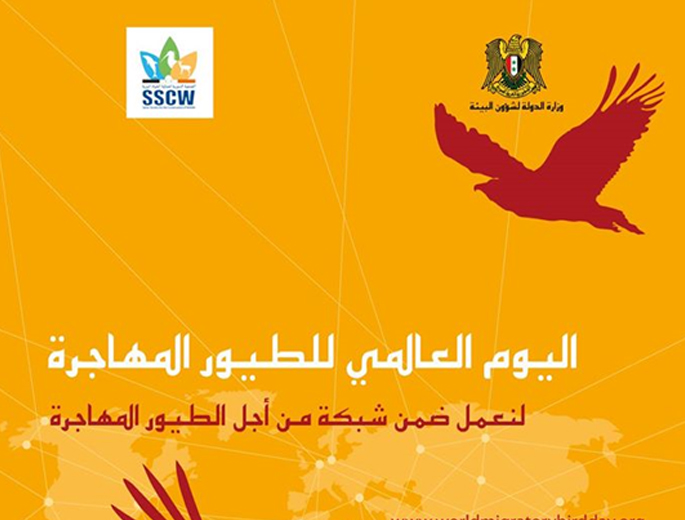
Under the patronage of H.E Dr. Nazira Sarkis the Minister of State for Environmental Affairs, Syrian Society for the Conservation of Wildlife (SSCW) and in cooperation with the Migratory Soaring Bird Project held a celebratory event for the World Migratory Bird Day (WMBD) under the title: (Networking of Activities at Bottleneck sites & Migratory Birds) Latakia, 10/11/2013.

Over forty representatives from different governmental and non-governmental institutions participated in this event. The Ministry of State for Environment Affairs (MSEA), Ministry of Agriculture and Agrarian Reform (MAAR), Ministry of Tourism(MoT), Ministry of Interior Affairs (MoIA), Environmental NGOs from Latakia and Tartous were represented at this event. Furthermore, representatives of the local community, peasants and hunters who can play a vital role in protecting the Migratory birds in the area, the only bottle neck site in Slenfeh – Latakia, were also among the attendees.
The workshop concluded in a session of discussion resulting in a series of recommendations at the Hunting and Agriculture Sectors as follows:
Recommendations in Hunting sector:
1 . Support establishing hunters` clubs in Syria depending on the modern law and encourage participation in regional initiatives like the regional meeting of responsible hunters in Beirut / December 2013.
2 . Concentrate on
importance of documenting the process of punishing irregular hunting and legal
actions that are supposed to be taken, and generalize it within the sector .
3 . Support engaging universities
and scientific centres through launching scientific programs in the field of
hunting, and move from documenting these studies toward required fields where
knowledge gaps exist.
4 . Focus on the importance
of issuing (the modern hunting law) and adopting the draft of the Action Plan
of the transitional phase toward the modern law that is presented by SSCW after
approving this draft by MAAR .
5. Set national red lists
of Syrian fauna and start this procedure by setting (the national red list of
birds in Syria).
6. Integrate the twenty five Important Bird Areas (IBA’s), which are adopted by
the study of BirdLife International` in 1994, on the national environmental map
as one of the environmental important areas . And re- achieve a comprehensive
study of these areas to define its real impact when conditions allow this.
7 . Document case studies
of hunting and its different methods in Syria within researches and specialized
studies and generalize their results.
8. Emphasize the importance of gender in influencing hunters to support
sustainable hunting practices.
9. Welcome the governmental plans to join the Raptors MoU under the
International Convention on Migratory Species (CMS) .
10. Release a national monitoring program of birds` markets in major cities to
pursue trade of living and dead birds in these markets systematically according
to the forms approved by BirdLife International/ MSB project for this purpose.
11. Emphasize the importance of the role of media and raising awareness`
programs to support sustainable hunting practices.
12. Observe the issues of hunting weapons and gunshots used for hunting as well
as the use of fire guns in illegal hunting in the draft of the modern hunting
law.
13. Distribute the final hunting report that SSCW is preparing currently in cooperation with the MSB project in BirdLife International on hunting sector impact on MSBs to the specialized national parties to use it in supporting future orientation of regulating hunting sector in Syria.
Recommendations in Agriculture sector:
1. Prepare a list of pesticides used in Syria, which are listed in Rotterdam Convention (PIC), and send it to Birdlife International- MSB project to check pesticides that threaten birds in order to suggest a list of replacements for the dangerous ones by MSB project.
2. Documenting case studies of agriculture sector and its impact on migratory soaring birds within researches and specialized studies and distribute their results.
3. Support engaging universities and scientific centers through launching
scientific programs in the field of agriculture and its impact on migratory
soaring birds, and move from documenting these studies toward required fields where knowledge gaps exist.
4. Emphasize the importance of the human element (male and female) in effecting
agricultural practices that have negative impact on migratory soaring birds.
5. Distribute the final Agriculture report that SSCW is preparing currently in
cooperation with the MSB project in BirdLife International on agriculture
sector impact on MSBs to the specialized national parties to use it in
supporting future orientations to integrating the protection of migratory
soaring birds with the agricultural field.
6. Integrate concepts of protecting migratory soaring birds in the EIA system
in the Ministry of State for Environmental Affairs (MSEA).
